Nathena “New Additive manufacTuring Heat ExchaNger for Aeronautic”
February 2017, one of the topics of the European Cleansky2 call for projects attracts the attention of many entities, companies and laboratories. This is a topic proposed by Liebherr Aerospace on new generation heat exchangers aimed at assessing the potential improvements that additive manufacturing can bring in this area.
SOGECLAIR aerospace then decided to set up a consortium. Indeed, additive manufacturing applied to complex products, in particular heat exchangers, has been developed there for nearly 10 years. The consortium will finally be composed of AddUp, a French manufacturer of powder bed metal additive manufacturing machines, TEMISTh, a French developer and supplier of customised thermal solutions, and the Von Karman Institute for Fluid Dynamics (VKI-FD), a Belgian fluid mechanics laboratory. SOGECLAIR aerospace, a high-tech engineering company in the aeronautical field, will be the project leader for the European Commission.
We have to take ownership of the project and give it a name. It will be NATHENA for New Additive manufacTuring Heat ExchaNger for Aeronautic. The project will last for 4 years with a total budget of €1.5M and will be 100% funded by the European Commission. Start date: March 2018.
The objective is to develop two innovative heat exchangers for the aeronautical industry. One is a “pre-cooler”, allowing the pre-cooling of hot air taken directly from the turbo-engines of an airliner. The second is a “cooler”, located further downstream in the air conditioning chain of the aircraft, allowing the air to be cooled again for later use. Due to their positioning, the pre-cooler will be designed in Inconel 718 as it is subject to very high temperatures, while the cooler will be designed in Aluminium AlSi7Mg, as it is subject to temperatures suitable for this alloy. The ambition of the project is to design heat exchangers that are as efficient as the existing ones but with a reduced mass and volume.
The first step of the NATHENA project was to establish a state of the art of heat exchangers from the point of view of design, numerical simulation, optimisation, bench testing and associated manufacturing techniques. The normative environment of aeronautical heat exchangers was also clarified, as well as the various patents relating to the fields listed above. This work has made it possible to guide and refine the architectural choices as well as the geometric parameters of the future intensification structures that will be developed and characterised during the project.
Considering previous work, the start of technical studies has led to the co-creation of the first CAD (Computer Aided Design) of new intensification structures by the project team (TEMISTh for thermal design, SOGECLAIR aerospace for mechanical design, and AddUp for the manufacturability of parts). The aim is to estimate their performance from a manufacturing, mechanical, fluidic and thermal behaviour point of view in order to select the most promising geometries. These are then integrated into standardised test channels for the project which are printed in Inconel and Aluminium on an AddUp FormUp 350.
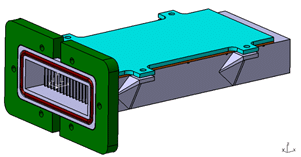
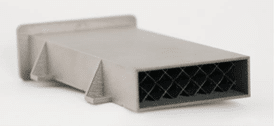
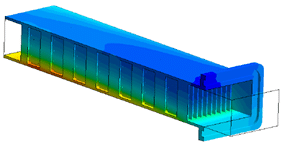
Just under 10 channels were printed in each material, one channel per intensification structure. These channels are then thermally tested on a test bench designed and operated by VKI-FD. The experimental results are then correlated with numerical simulations performed by Temisth (CFD simulations: Computational Fluid Dynamics). The principle: air at room temperature with controlled properties is introduced at the entrance of the channels while these are heated via a flat electrical resistor attached to one of their walls. Multiple sensors then measure the pressure, temperature and velocity of the gas at different positions in the channels. These measurements are then used to consolidate the validity of the numerical simulation models and to compare the performance of the different structures.
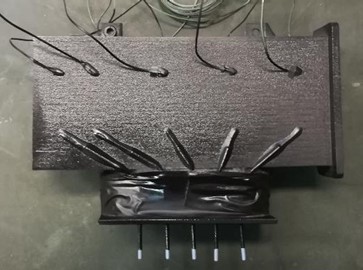
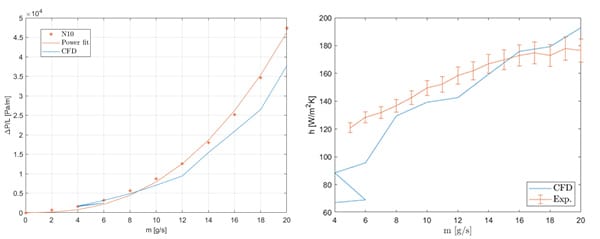
The consortium was able to obtain at this stage a better understanding of the flows and heat transfers in different structures produced by additive manufacturing. The manufacturability of such geometries, particularly from a thin-wall point of view, has also been evaluated. The initial results are very encouraging and have already made it possible to outline the best performing heat exchanger architecture, offering the best compromise between manufacturability, mechanical strength, thermal performance and fluid performance.
This study on representative channels enabled the selection of the intensification structure offering the best compromise between mechanical, fluid and thermal performance and manufacturability. It then led to a campaign of similar tests, this time involving two fluids, hot and cold. The aim here is to characterise the performance of the chosen geometry in a miniature heat exchanger where the hot source is no longer an electrical resistor, but a flow of hot air. The configuration of the channels will here be a crossed configuration.
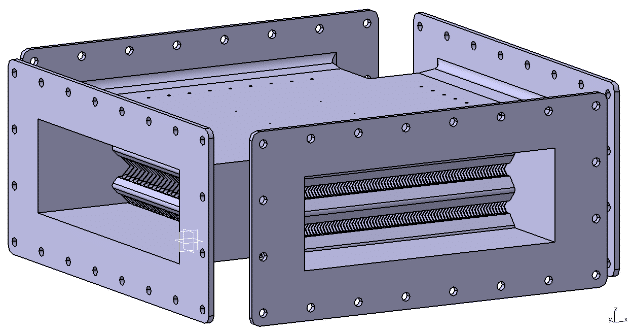
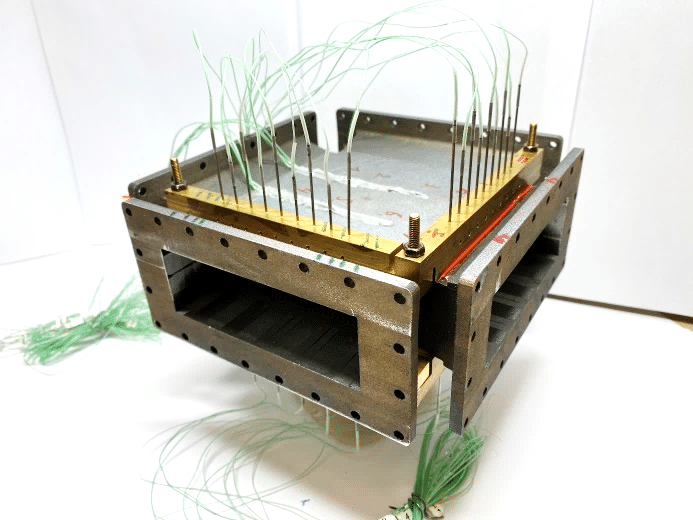
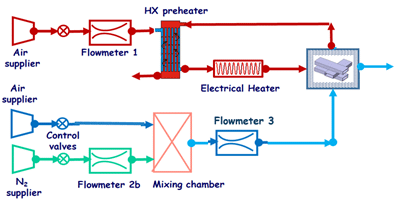
Three two-fluid channels were printed: two in Inconel and one in Aluminium, for which the parametrics of the intensification structures were calculated and adapted according to the airflow characteristics. This was a first challenge for the manufacturing process as it was necessary to manage the thin walls of the fins and their large number (several thousand), while ensuring good printing quality, de-powdering and finishing of the parts. The channels were then characterised on a test bench, once again allowing experimental tests and numerical simulations to be correlated.
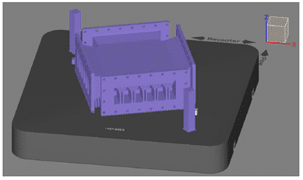
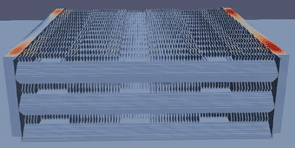
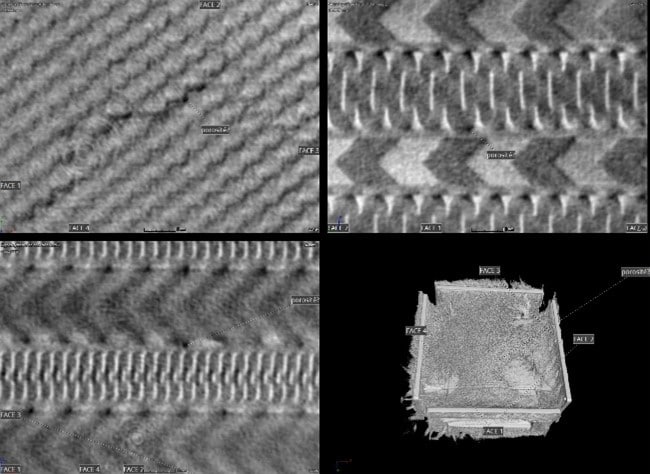
Thanks to a homogenisation method, these thermo-fluidic characterisations have enabled the creation of metamaterials (“Equivalent Porous Media” or EPM with equivalent volume properties) which make it possible to simplify the numerical simulations by lightening the models and reducing the calculation time. A mechanical equivalent was also carried out by correlating numerical simulations with tensile tests of specimens, also produced in Inconel 718 and Aluminium AlSi7Mg. The correlation between the tensile test and the simulation will allow the determination of a homogeneous medium which will subsequently simplify the thermomechanical calculations. Indeed, a heat exchanger is a system with small, complex and numerous geometries in a large volume. To simulate them numerically can be very complex and require considerable computer resources if such techniques are not employed.
At the time of writing, the chosen intensification structure has been characterised and its manufacturability has been tested and validated in a typical cross-flow heat exchanger structure. The design of the two final heat exchangers has started based on Liebherr Aerospace specifications. They will be numerically simulated, produced and bench tested to validate their performance.
NATHENA: the consortium
SOGECLAIR aerospace
With its roots in aeronautics, the SOGECLAIR group designs, manufactures and supports innovative solutions and products for transport in the civil and military fields.
Its R&D policy supports its participation in major future programmes such as the development of the aircraft of the future and autonomous vehicles.
Its subsidiary, SOGECLAIR aerospace, is an international leader in the design and integration of high value-added solutions for the aerospace industry. It designs, manufactures and maintains the main components of aerostructures and aircraft interiors.
SOGECLAIR aerospace develops and deploys advanced materials and technologies such as thermoplastic and additive manufacturing.
With more than 1600 employees worldwide, SOGECLAIR aerospace has a recognized know-how in:
- Design and architecture of aerostructures and systems,
- Design and manufacture of aircraft interiors,
- Configuration management at programme, engineering and industrial level,
- Design and manufacture of simulated and embedded equipment.
AddUp
AddUp, created in 2016, is a joint venture from Fives and Michelin. It is a provider of complete industrial metal 3D printing solutions.
AddUp is involved in:
- Design and manufacture of machines, integrated in a complete production line, from powder management to the finished part,
- Customer support for the production of metal parts, to support investment projects in additive manufacturing or additional production needs,
- Cross-functional service activity, including the redesign of parts and additional services associated with the machine offering, to help companies find the most appropriate technical and financial solutions.
TEMISTh
TEMISTh is a company specialised in the development and supply of customised thermal solutions. To do so, the company develops numerical simulation and optimisation tools for automated heat exchanger design. This allows the company to develop new heat exchanger concepts to be produced in particular by additive manufacturing.
Thanks to its location at the TEAM Henri Fabre Technocentre, TEMISTh offers various advanced manufacturing technologies such as metal and polymer additive manufacturing, foundry, machining and assembly for function hybridisation through brazing or friction welding. TEMISTh’s mastery of all these processes enables it to offer optimised and successful solutions to all its customers. All parts developed and produced can then be tested on TEMISTh’s thermal test benches.
The industrial fields in which the company operates are numerous: aeronautics, space, transport, oil and gas, electronics.
Von Karman Institute for Fluid Dynamics
The Von Karman Institute for Fluid Dynamics (VKI-FD) was founded in 1956 by Professor Theodore Von Karman as an international centre combining education and research for the citizens of NATO countries under his motto “Training in research through research”.
Educational programmes provided: Conferences / Courses / Colloquia, Short Courses, Master’s Thesis, Master of Research in Fluid Dynamics, Doctoral Programme and Applied Research Programme.
The VKI-FD undertakes and promotes research into experimental, computational and theoretical aspects of liquid and gas flows in the fields of aeronautics, aerospace, turbomachinery, environment, industrial and safety processes. Some 50 specialised test facilities are available, some of which are unique or among the largest in the world.
Research is conducted under the direction of faculty and research engineers, mainly sponsored by governmental and international agencies, as well as by companies.
Liebherr Aerospace
Liebherr Aerospace designs, develops and manufactures air systems, flight control systems and landing gear, as well as gears and gearboxes and electronics for the aerospace industry. Liebherr Aerospace provides complete OEM customer services through a global network that offers: equipment repair and overhaul, technical support and documentation, spare parts supply and AOG service.
